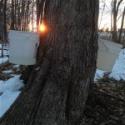Maple Trader post:
Pan siphons
I saw a few threads on here for creating pan siphons so I made these for my 5 pans on my oil tank evaporator. Not only did these make the whole process WAY more efficient as no matter which pan evaporates fastest the other pans are automatically balancing but it saved my poor wrist from ladling from one pan to the next!
Here are the siphons being used in different patterns. I don't have a valve on the top because (I fear burned lips so) I'd lay them down in the sap and because the "boots" held the legs up at a slight angle the air would flow out, I'd bounce them once to release any trapped air, then hook the top pipe and place it between the necessary pans. It worked great!
Attachment 16380 - Siphon draw-off
Attachment 16381 - Dual run to front pan
Attachment 16382 - S-pattern
Syrup hydrometer
I wanted to understand the finishing process better so I bought a hydrometer. Here is a picture in my "hydrometer cup" which is a stainless steel vodka bottle with the top cut off and the handle held on with a 4" hose clamp. Though a little ridiculous I felt better than using my tall cone-shaped beer glass which I always worried would shatter and waste a bunch of syrup!
Attachment 16383
Pre-heater Proof of concept
After evaluating different methods for pre-heating which included: running a wort chiller through a pre-heated pan of water, wrapping a double stack that would divert exhaust through one stack or the other, and just heating on a propane burner. My evaporator goes at about 8-10GPH and only the propane burner really kept up with the heating.
Challenges/concerns of a stack-wrapped pre-heater:
- heating too much/not enough as it depends on stack temperature, sap temperature, length/diameter of copper pipe
- concern of air/steam trapped in the copper tubing causing blockages and/or scary releases
- how to manage all this while everything else is going on!
Here is my rough solution to test the concept with manual valves so that I understand the flow challenges prior to testing actual heating.
Attachment 16384
- Valves at the input/output that are "normally closed"
- Feedback loop that allows for recirculation when both valves are closed
- Air tube to allow steam/air escape and also acted like a sight/sound tube to know if the recirculation had enough water (not by design, more of useful observation)
- Temperature probe to know how hot the circulating water is (this will be moved to a screw in probe that ties back to a thermostat)
- Solar hot water heater pump to handle the temperature and flow considerations (I still needed to elevate my input to keep the pump primed)
- Coil feeds at the bottom and flows up as I read that downward flow could encounter air blocks from bubbles attempting to rise up
- There is a ball valve on the feedback loop but I'm not totally sure it is necessary
- My temperature meter was a HUGE help in evaluating what was happening in each variation on design/testing. It can take different types of k-type thermostat leads and/or probes and was only $32 on Amazon -- 4-Channel K-Type Digital Thermometer Thermocouple Sensor -200~1372°C/2501°F
Next year I plan on implementing this using an automated method with pieces like:
- A couple of these for the inlet/outlet:
1/2" Water Brass Solenoid Valve Normal Close Electromagnetic valve 3-25L/M 0-80C 12V 5.2W
OR
Motorized Ball Valve- 1/2" Stainless Steel Electrical Ball Valve with Full Port, 9-24V DC and 3 Wire Setup
- Temperature controller w/k-type screw in thermostat and relay for 12V activation of solenoid/ball valves
*** Method of operation:
- (Without the temperature controller) Turn on pump and charge/turn-on both solenoids (this will open the normally-closed solenoid) to prime the system
- Unplug when full/primed which should turn off the pump and solenoids should close which will trap the water in the system
- Plug in temperature controller which is set to cooling mode so when the circulation hits 185F+ it will charge the solenoids to open the inlet/outlet to "cool" or draw in more sap
- When it hits 150F (arbitrary temp) it will stop charging the solenoids (they close and recirculation starts again) until the temperature hits the given temp again
Hope people find this useful!
Cheers - Tom in MA













 Reply With Quote
Reply With Quote






